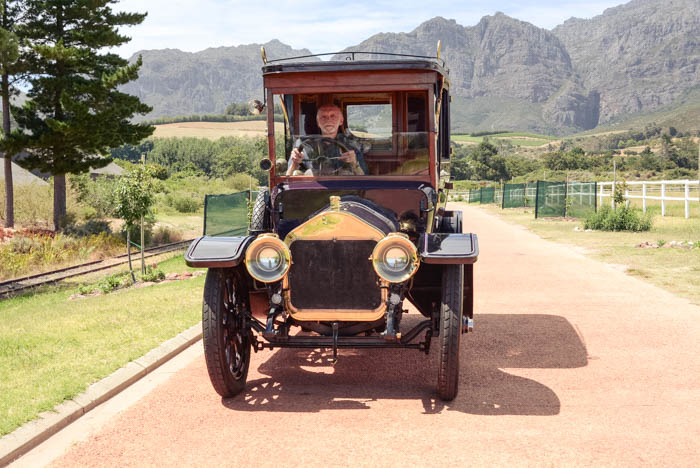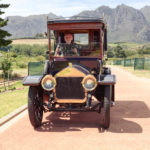
01 Dec COLLECTION IN ACTION – W
An alphabetical series of short driving impressions of some of the museum’s car collection. This month we pilot an early example of one of the pioneering British makes, Wolseley.
The history of Wolseley goes back to 1887, when Dublin-born Frederick York Wolseley established the Wolseley Sheep-Shearing Machine Company to make the most of the many patents he had devised for sheep-shearing equipment while working in Australia. Herbert Austin was working Down Under at the time and took an interest in the company, pointing out to Wolseley where his design and construction methods were going wrong. Wolseley was impressed and Austin was appointed manager in 1893. Wolseley later resigned, then passed away in 1899.
By this time the company had been set-up in Birmingham, England and was operating successfully, even to branching out to make bicycles. Then Austin’s entrepreneurial spirit led him to travel to Paris to look at the pioneering horseless carriages that were all the rage. Inspired by what he saw, he returned home and produced his own three-wheeler that was a modified copy of a Léon Bollée. However, due to patent rights, the car was never produced.
Undaunted, Austin made a second car, also a three-wheeler but with the single wheel at the front. Again, no more were made despite a catalogue (one of the industry’s first?) being made for the car. Austin then made a four-wheeler with a single-cylinder 3,3 hp (2,5 kW) horizontal engine and took part in a 60 km timed run from Birmingham to Coventry and back. He finished second.
Then machine gun inventor Hiram Maxim joined in. Maxim was a member of the Vickers, Sons & Maxim Company and had consulted Austin a number of times regarding the design of flying machines that he was developing and constructing. Wary of becoming too involved in the motor car business, this friendship led to the sheep-shearing side pulling away to allow the Wolseley Tool and Motor Car Company to be incorporated in March 1901 with a capital of £40 000 by Vickers, Sons & Maxim to manufacture motor cars and machine tools, with 33-years-old Austin as managing director.
By May 1901 the company issued its first catalogue of Wolseley cars. At this time there was a diversion of opinion over engine layouts, a minority advocating a horizontal layout while a vertical design was the more popular approach. Austin was a ‘horizontal man’, which put Wolseley at odds with its rivals and the company made a loss in its first 10 months. Profits were made in 1902 and 1903 and prizes were won in sporting events and at motor shows, but these were followed by five years of losses, brought about mainly by component supply issues.
Austin agreed to build the vertically-engined Siddeley, named after its originator John Davenport Siddeley. The car outsold the Wolseley and so Austin bought out the company and J D became sales manager. But in 1905 a frustrated Austin resigned, leaving J D as general manager. At the Olympia Motor Show, newly-badged Wolseley-Siddeley cars with both vertical and horizontal engines were displayed. Wolseley’s fate was seen to be turning, as was Austin’s – once his contractual obligations to the Wolseley Tool and Motor Car Company ended, he established The Austin Motor Company Limited.
Banker Lionel Nathan de Rothschild joined the company bringing his money, but the board was unhappy because people were calling the cars simply Siddeleys and profits were marginal. In 1909 the dissatisfaction led to both Siddeley and De Rothschild leaving the company, opening the door for Ernest Hopwood to move from the British Electric Traction Co to become managing director. He was joined by A J McCormack in 1911 as a period of stability began, instigated by board member Walter Chetwynd. The company regrouped into fewer premises, and the Siddeley name was dropped. Wolseley began making a profit and by 1913 it was Britain’s largest car manufacturer, selling 3 000 cars.
During this time Wolseley introduced the 12-16, which proved to be a very popular model. The car in the FMM collection was acquired from the Waldie Greyvensteyn collection in 1977 and is a 1912 Town Car model with an ornate body by Hurst of Belfast. Although the roof extends to the top of the windscreen – it carries a roof rack for luggage – the rear passenger compartment is separated by a split glass screen, the top half hinged so that conversation with the driver can be made. Upholstery is in rich cerise-coloured studded velvet, the hue matching the pin-striping on the purple painted bodywork. The windows drop down into the doors old railway carriage-style by means of a brocade-edged sash. An elegantly-patterned headlining edged with tassels adds to the classy ambience. Access to the front is from the passenger side only, and the sculpted dual seat is trimmed in leather.
The 12-16 is powered by a 2 226 cm3 four-cylinder side-valve engine with a single Zenith carburettor. The 12 refers to the RAC horsepower rating: the engine produced 15 hp (11 kW) at 1 800 r/min. Once the priming cocks have been utilised, the motor swings into life at the first turn of the crankhandle and pulls away with enthusiasm thanks to a low first gear. Top – third – gear is high, leaving flexible second to bear the brunt of the drive to the back axle. As regular readers will know, my long-legged frame is not commensurate with veteran and vintage ergonomics – the pedals are mounted very close together forcing me to drive shoe-less in order to operate the central accelerator, while the top of the gear lever sits in the crook of my right knee. Ah, the joys of pioneering motoring…
The 12-16 was certainly no slouch. A speeding fine was issued on the car for travelling at 143 km/h in a 120 km/h zone in Alberton, only for it to be found that someone was illegally using the Wolseley’s number plates…
The thick-rimmed steering wheel is not overly large and steering effort not too heavy once on the move. Tyres are 815x105s mounted on wooden artillery wheels. The chassis has a wheelbase of 2 819 mm and weighs 762 kg. Suspension is by leaf springs all round and the foot brake operates on the drive shaft while the handbrake works on the rear wheels. The Lucas King of the Road headlamps were powered by a running board-mounted ‘generator’, a cylinder containing calcium carbide that when topped up with water produces acetylene, which ran through pipes to the headlamps where it could be ignited to produce light.
I wonder what thrills the early motorists must have had driving around in such self-propelled elegance. It could not have been easy, but even by 1910 a level of sophistication was already apparent as the motorised age was fast gathering momentum. Wolseley certainly set a high standard and little wonder the 12-16 was a success.
The company was renamed Wolseley Motors Limited in 1914 and set up operations in Canada and later began a joint venture in Japan with Ishikawajima Ship Building and Engineering, a coalition that was the foundation of Isuzu Motors in 1949. The company grew and prospered and in 1921 manufactured 12 000 cars, continuing to be Britain’s biggest motor manufacturer. However, over-expansion led to receivership in 1927 when it was purchased from Vickers by William Morris (later Lord Nuffield), who pre-war had bought a Wolseley taxi. Up to this point, at various times Wolseley had built motor cars, aircraft, aero-engines, gliders, railcars, a gyro car, boats, armoured cars, buses and ambulances, not to mention mines and depth-charges. Wolseley was incorporated into the Morris Motors empire where it became a badge-engineered product under BMC, BMH and British Leyland ownership before the name was dropped altogether in 1975, an unflattering finale to what was once an eminent force. MM




